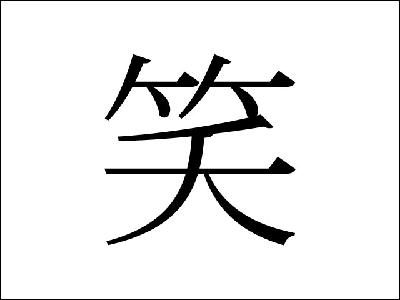【笑(若)】 Shou, Warau (Jyaku, Wakai, Moshikuha) Laugh (Young; Maybe)
|
There may be some people who wonder what at all 笑う ‘warau: laughing’ has to do with 竹 ‘bamboo,’ as the Chinese characters supposes. As, among living creatures, laughing is a characteristic of human beings this character also somehow has to depict the image of a human being.
The part 竹 ‘bamboo,’ which became the classifier actually is a part of the body, the arms. It is the form of a female shaman calling for a divine message, laughing in an ecstasy-like state of mind, dancing while waving the hands over her head. Therefore, the ancients thought that laughing brings human beings close to the gods.
There is neither a tortoise plastron and bone character nor a bronze inscription of 笑. For the first time it appears in the Tenbun (Zhuàn Wén) seal. What has now become the so called grass classifier at the top of 若, of which tortoise plastron and bone inscriptions do exist, also shows hands and is the form of a dancing female shaman with raised hands. The meaning ‘young’ of the character 若 probably came from the female shamans usually being young of age. Furthermore, its other meaning ‘maybe’ has its origin in that transmission of a divine mission was not guaranteed. Later, starting with the form of the bronze inscriptions, 口, the shape of a prayer writing receptacle was added and from there it developed into the present character form.
The part 竹 ‘bamboo,’ which became the classifier actually is a part of the body, the arms. It is the form of a female shaman calling for a divine message, laughing in an ecstasy-like state of mind, dancing while waving the hands over her head. Therefore, the ancients thought that laughing brings human beings close to the gods.
There is neither a tortoise plastron and bone character nor a bronze inscription of 笑. For the first time it appears in the Tenbun (Zhuàn Wén) seal. What has now become the so called grass classifier at the top of 若, of which tortoise plastron and bone inscriptions do exist, also shows hands and is the form of a dancing female shaman with raised hands. The meaning ‘young’ of the character 若 probably came from the female shamans usually being young of age. Furthermore, its other meaning ‘maybe’ has its origin in that transmission of a divine mission was not guaranteed. Later, starting with the form of the bronze inscriptions, 口, the shape of a prayer writing receptacle was added and from there it developed into the present character form.
- name
- Editoral supervision: Dr. Christoph Schmitz, Researcher of Shirakawa Kanji Science, General and Japanese History of Philosophy and Thought
- hp
- http://nippon-kichi.jp/article_list.do?p=5332















